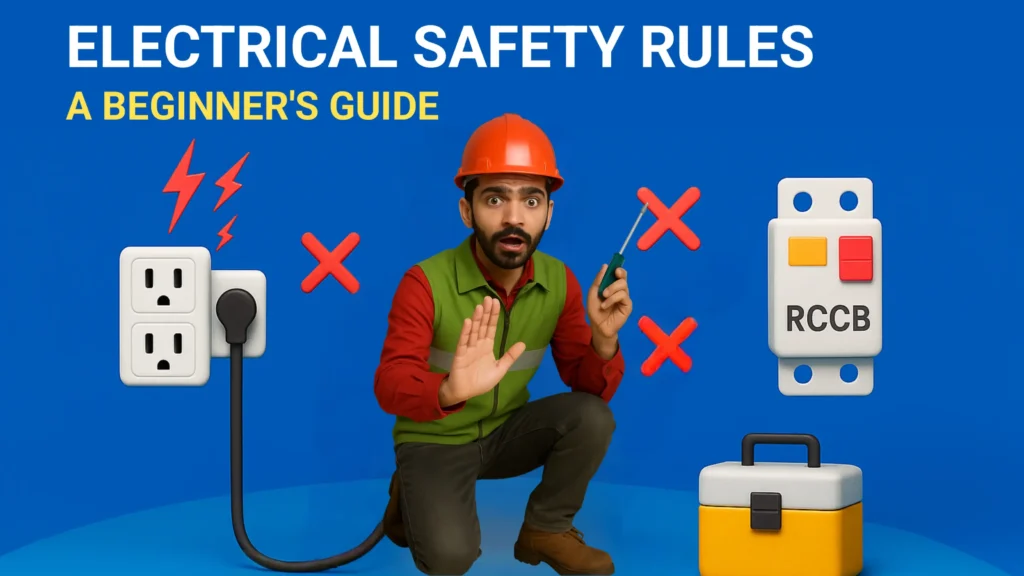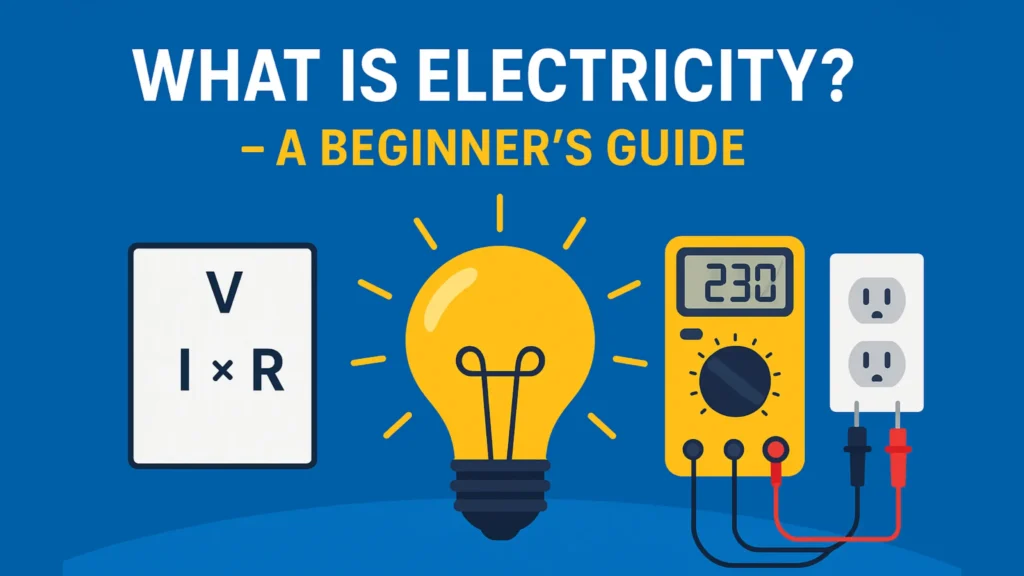
Part 2 of our Electrical Learning Series teaches you electrical safety rules for beginners so you can protect yourself before starting any electrical work. From turning off the power and using insulated tools to wearing protective gear and avoiding common mistakes, this guide covers everything a beginner needs to know. We’ve also included recommended safety tools and equipment (affiliate links) to help you work smarter and safer.
Disclosure: This post contains affiliate links. If you purchase through these links, we may earn a small commission at no extra cost to you. This helps support our work and keeps our Electrical Learning Series free for readers.
Electrical Safety Rules for Beginners
Welcome to Part 2 of our Electrical Learning Series.
In Part 1 – What is Electricity? – we covered the basics of electricity, how it works, and why understanding it is important before handling electrical systems.
Now that you know the fundamentals, it’s time to focus on something even more important—your safety.
Electricity can be extremely dangerous if handled incorrectly. A small mistake can lead to shocks, burns, or even life-threatening injuries. That’s why in this guide, we’ll go step-by-step through electrical safety rules for beginners, so you can protect yourself before you even touch a wire.
Let’s start with electrical safety rules for beginners below. 👇👇
Table of Contents
💹 Understand the Risks of Electricity
Before working on anything electrical, you need to know what can go wrong:
- Electric shock – Can cause muscle paralysis, burns, or death.
- Burns – Sparks or arcs can cause severe skin injuries.
- Fires – Overloaded circuits and faulty wiring can ignite fires.
Tip: Always treat all wires as if they are live until proven otherwise with a voltage tester.
📴 Turn Off the Power Before You Start
This is the golden rule of electrical safety.
- Switch off the power from the main breaker.
- Use a voltage tester to confirm no current is flowing.
- If others are present, lock or tag the breaker (Lockout-Tagout method) to avoid accidental switching.
🦺 Wear Proper Personal Protective Equipment (PPE)
Your safety gear is your shield against accidents:
- Insulated gloves – Prevent electric shock. – Buy Now
- Safety goggles – Protect eyes from sparks and debris. – Buy Now
- Rubber-soled shoes – Reduce grounding risk. – Buy Now
- Avoid loose clothing or jewelry that could catch on wires. – Buy Now
- Safety Helmet to reduce the risk of head injuries by absorbing and distributing the impact from falling objects, collisions, or other hazards. – Buy Now
💦 Keep Water and Moisture Away
Water is a conductor of electricity, making it extremely dangerous in electrical work:
- Work in dry areas only.
- Stand on a dry, insulated mat.
- Always keep hands dry.
🔃 Follow Wiring and Load Guidelines
Every circuit and wire has a safe load capacity:
- Never overload sockets or extension cords.
- Use the correct wire gauge for the job.
- Follow local electrical codes to avoid hazards.
🧮 Learn Wire Color Codes and Diagrams
Understanding wire identification is crucial:
- Live (Phase): Red, brown, or black.
- Neutral: Blue or white.
- Earth (Ground): Green or yellow-green.
Tip: Always confirm with a wiring diagram before making connections.
⚒️ Keep Your Workspace Organized
A cluttered space can lead to mistakes:
- Keep wires neatly arranged.
- Ensure good lighting.
- Store tools safely when not in use.
🕜 Never Work Alone
Electrical work can be unpredictable, even if you’re careful. Having another person nearby can make a huge difference in case of an emergency.
- If you get an electric shock, lose balance, or fall, your partner can cut the power and call for help immediately.
- They can also pass you tools, hold a flashlight, or keep an eye on wires while you work, making the process safer and faster.
- In worst-case scenarios, a second person can start CPR or provide first aid while waiting for emergency services.
Tip: Make sure the person with you understands basic safety rules and knows where the main breaker and first-aid kit are located.
🎯 Know Your Limits
Some electrical jobs are too complex or risky for beginners.
- If you feel unsure, stop immediately and call a licensed electrician.
- High-voltage tasks, main breaker work, and rewiring are not safe for DIY beginners.
- Safety is always worth more than saving money on labor costs.
Tip: Confidence comes with learning—start small and build up your skills safely.
❌ Common Mistakes Beginners Should Avoid
- Working without turning off power.
- Ignoring grounding requirements.
- Using incorrect wire sizes.
- Overloading extension cords.
🚨 Emergency Action Steps
- If someone gets shocked—turn off the power before touching them.
- Call emergency services immediately.
- If trained, perform CPR until help arrives.
Conclusion Electrical Safety Rules for Beginners
Electrical work can be safe and rewarding—if you follow the right safety rules. As a beginner, taking precautions like turning off the power, using insulated tools, wearing protective gear, and never working alone can make all the difference. Remember, safety isn’t just a guideline—it’s the foundation of every electrical project.
By applying these electrical safety rules for beginners, you’ll protect yourself, avoid costly mistakes, and gain confidence in your skills. And with the right tools and equipment (check our recommended list above), you can work smarter, safer, and with peace of mind.
Stay safe, keep learning, and watch out for Part 3 of our Electrical Learning Series—coming soon!
💡 If you found this guide helpful, share it with friends and explore other parts of our Electrical Learning Series to power up your knowledge.
👇 If you missed Part 1 – What is Electricity?, read it first to build your foundation. In Part 3, we’ll move deeper into basic electrical tools and their uses.
Remember: Safety first—always. By following these rules, you protect yourself, your equipment, and your home from avoidable accidents.
❓ FAQs on Electrical Safety Rules for Beginners
What are the basic electrical safety rules for beginners?
Turn off the power, use insulated tools, wear PPE, keep water away, and never work alone.
Why is it important to turn off the main power before electrical work?
It ensures you avoid contact with live current, which can cause injury or death.
What tools should I use for safe electrical work?
Insulated screwdrivers, pliers, voltage testers, and wire strippers.
Can I do electrical work myself as a beginner?
Yes, for simple tasks—if you follow safety rules. For complex work, hire a professional.
How can I avoid electric shocks at home?
Turn off the power, keep hands dry, use insulated tools, and avoid wet conditions.


Pingback: What is Electricity? – A Beginner’s Guide (Electrical Learning Series – Part 1) -
Pingback: Basic Electrical Tools and Their Uses : (Electrical Learning Series – Part 3) -
Pingback: Wiring Basics Introduction to House Wiring – Level 2 (Part 4) -
Pingback: 1-Way Switch Connection: Diagram, Step-by-Step Guide & Common Mistakes to Avoid - Home Fitting